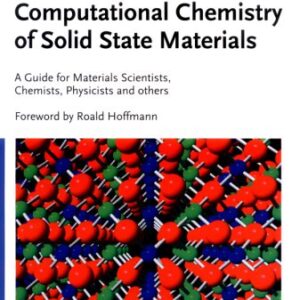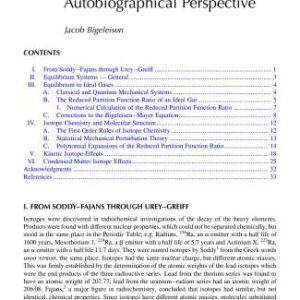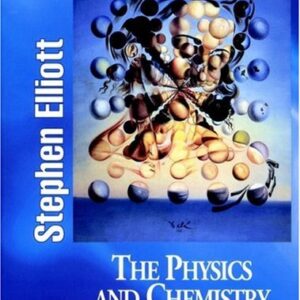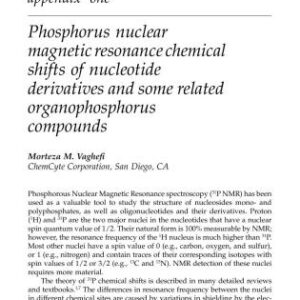“Practical Aspects of Computational Chemistry” presents contributions on a range of aspects of Computational Chemistry applied to a variety of research fields. The chapters focus on recent theoretical developments which have been used to investigate structures and properties of large systems with minimal computational resources. Studies include those in the gas phase, various solvents, various aspects of computational multiscale modeling, Monte Carlo simulations, chirality, the multiple minima problem for protein folding, the nature of binding in different species and dihydrogen bonds, carbon nanotubes and hydrogen storage, adsorption and decomposition of organophosphorus compounds, X-ray crystallography, proton transfer, structure-activity relationships, a description of the REACH programs of the European Union for chemical regulatory purposes, reactions of nucleic acid bases with endogenous and exogenous reactive oxygen species and different aspects of nucleic acid bases, base pairs and base tetrads.
Table of Contents
Cover
Practical Aspects of Computational Chemistry I
ISBN 9789400709188
Preface
Contents
Contributors
Chapter 1: Models–Experiment–Computation: A History of Ideas in
Structural Chemistry
1.1 Introduction
1.2 Frank Westheimer and the Origin of Molecular Mechanics
1.3 Gilbert N. Lewis’s Models of Atoms and Bonding
1.4 VSEPRing an Efficient Model
1.5 Non-bonded Interactions
1.6 Origins of Experimental Molecular Structure Determination
1.7 Structural Chemistry in Molecular Biology
1.8 The Theory of Resonance and the Discovery of Alpha-Helix
1.9 Some Major Contributors to the MO Approach
1.10 Physical Content of Metric
1.11 John A. Pople’s Comprehensive Program
1.12 Final Thoughts
References
Chapter 2: Many-Body Brillouin-Wigner Theories: Developmentand
Prospects
2.1 Introduction
2.2 Brillouin-Wigner Theories
2.2.1 Brillouin-Wigner Expansions
2.2.2 Single-Reference Brillouin-Wigner Expansions
2.2.3 Multi-Reference Brillouin-Wigner Expansions
2.2.4 Rayleigh-Schr?dinger and Brillouin-Wigner Perturbation
Theories and A Posteriori `Many-Body’ Corrections
2.3 Digression: Collaborative Virtual Environments for Many-Body
Brillouin-Wigner Theories
2.4 Applications of Many-Body Brillouin-Wigner Theories
2.5 Future Directions
2.5.1 Relativistic Many-Body Brillouin-Wigner Theories
2.5.2 Fock Space Brillouin-Wigner Methods
References
Chapter 3: Multireference State-Specific Coupled Cluster Theory with a
Complete Active Space Reference
3.1 Introduction
3.2 Multireference State-Specific Generalization of CCSD Theory
3.2.1 The CASCCD Method
3.3 Multireference State-Specific Coupled Cluster Theory with
Complete Account of Single and Double Excitations: The CASCCSD
Method
3.4 Automated Derivation of the CC Equations and Generation of the
Computer Code for Solving Them
3.5 Numerical Results
3.6 Conclusions
References
Chapter 4: Relativistic Effects in Chemistry and a Two-Component
Theory
4.1 Introduction
4.2 Relativistic Effects in Atoms and Molecules
4.2.1 Dissociation Energies and Strong Chemical Bonds to Gold
4.2.2 Electric Properties
4.2.3 Chemical Reactions
o 4.2.3.1 Equilibrium Reaction Energies
o 4.2.3.2 Hydrolysis of Group 11 and 12 Cations
4.2.4 Atomic Core Ionization Potentials
4.2.5 Molecular Core Electron Binding Energies
4.3 Basis of Relativistic Theory
4.3.1 One-Electron Dirac Equation
4.3.2 Relativistic Theory of Many-Particle Systems
4.4 Two-Component Relativistic Theories
4.4.1 Infinite Order Two-Component Method (IOTC)
4.4.2 Matrix Formulation
4.5 The Change of Picture Problem
4.6 Quasi-Relativistic or Exact Two-Component Method
4.7 Summary
References
Chapter 5: On the Electronic, Vibrational and Relativistic
Contributions to the Linear and Nonlinear Optical Properties of
Molecules
5.1 Introduction
5.2 The Correlation, Relativistic and Vibrational Contributions to
the L&NLO Properties of ZnS, CdS and HgS
5.3 Vibrational Corrections by Numerov-Cooley Integration
5.4 Relativistic Corrections of the L&NLO Properties of Coinage
Metal Hydrides
5.5 Cyclopropenone and Cyclopropenethione
5.6 Hyperpolarizabilities of the Hydrides of Li, Na and K
5.7 Electronic and Vibrational Contributions to Pyrrole
5.8 Linear and Nonlinear Optical Properties of Fullerene
Derivatives and Endohedral Fullerenes
5.8.1 Substituted Dihydro-Fullerenes
5.8.2 Endohedral Fullerenes
o 5.8.2.1 Nuclear Relaxation Contribution to the
VibrationalNLO Properties
5.9 Nonlinear Optical Properties Due to Large Amplitude
Vibrational Motions, with an Application to the Inversion Motion
in NH3
5.10 Summary
References
Chapter 6: Using Chebyshev-Filtered Subspace Iteration and Windowing
Methods to Solve the Kohn-Sham Problem
6.1 Introduction
6.2 Eigenvalue Problems in Density Functional Calculations
6.3 Numerical Methods for Parallel Platforms
6.4 The Nonlinear Chebyshev-Filtered Subspace Iteration
6.4.1 Chebyshev-Filtered Subspace Iteration
6.4.2 Chebyshev Filters and Estimation of Bounds
6.5 Window Filtering
6.6 Diagonalization in the First SCF Iteration
6.7 Numerical Results
6.8 Concluding Remarks
References
Chapter 7: Electronic Structure of Solids and Surfaces with WIEN2k
7.1 Introduction
7.2 Quantum Mechanics
7.3 The Augmented Plane Wave Based Method and WIEN2k
7.4 Properties and Applications
7.4.1 Verwey Transition in YBaFe2O5
7.4.2 Nanomesh with h-BN on a Rh(111) Surface
7.4.3 The Misfit Layer Compounds
7.4.4 Performance of Various GGA Functionals
7.5 Summary and Conclusion
References
Chapter 8: Model Core Potentials in the First Decade of the XXI
Century
8.1 Introduction
8.1.1 Separability of the Valence and Core Spaces
8.1.2 Effective Core Potential Method
8.1.3 Model Core Potential Method
o 8.1.3.1 General Formalism of Model Core Potential Method
o 8.1.3.2 Versions of the Model Core Potential Method
8.1.4 Determination of the Model Core Potential Parameters
8.2 General Improvements in Parameterization and Basis Sets
8.3 New Approach to Relativistic Effects
8.3.1 Scalar-Relativistic Effect in Model Core Potential
Method
8.3.2 Spin-Orbit Coupling in Model Core Potential Method
o 8.3.2.1 Breit-Pauli and Douglas-Kroll
Spin-Orbit-Coupling Operators
o 8.3.2.2 Determination of the Model Core Potential
Valence Space
o 8.3.2.3 Basis Sets for the New Model Core Potentials
o 8.3.2.4 Performance of the DK-SOC Adapted Model Core
Potential
8.3.3 A Digression: From MCP to SOC
8.4 Model Core Potential Applications in the Last 10 Years
8.5 Summary and Outlook
References
Chapter 9: Practical Aspects of Quantum Monte Carlo for the Electronic
Structure of Molecules
9.1 Introduction
9.2 Quantum Monte Carlo Approaches
9.2.1 Variational Monte Carlo (VMC)
9.2.2 Diffusion Monte Carlo (DMC)
9.2.3 Fixed-Node DMC (FN-DMC)
9.2.4 Self-Healing DMC (SH-DMC)
9.2.5 Auxiliary Field QMC (AF-QMC)
9.2.6 Reptation QMC (RQMC)
9.2.7 Full CI QMC (FCI-QMC)
9.2.8 Time-Dependent QMC (TD-QMC)
9.2.9 Applications
9.3 Trial Wave Functions
9.3.1 Antisymmetric Wave Functions
9.3.2 Backflow Transformed Wave Functions
9.3.3 Effective Core Potentials (ECP)
9.3.4 Jastrow Wave Functions
9.3.5 Trial Wave Function Optimization
9.4 Computational Considerations
9.4.1 Scaling Analysis
9.4.2 Molecular Orbital Evaluation
9.4.3 Correlation Function Evaluation
9.4.4 Load Balancing
9.4.5 Parallelization and Hardware Acceleration
9.5 Conclusions
References
Chapter 10: Relativistic Quantum Monte Carlo Method
10.1 Introduction
10.2 Qumatum Monte Carlo Method
10.2.1 Quantum Monte Carlo Foundations
10.2.2 Variational Monte Carlo Method
10.2.3 Diffusion Monte Carlo Method
10.2.4 Wave Functions and Selective Sampling in Optimization
10.2.5 Electron-Nucleus Coalescence Condition
10.3 Relativistic Quantum Monte Carlo Method
10.3.1 Dirac Hamiltonian
10.3.2 Breit-Pauli Hamiltonian
10.3.3 ZORA Hamiltonian
10.3.4 Implementation of the ZORA Method into the MO Program
10.3.5 Local Energy for ZORA Hamiltonian
10.3.6 Electron-Nucleus Cusp Condition in ZORA-QMC Method
10.3.7 Cusp Correction Algorithm
10.4 R4QMC Program
10.5 Illustrative Results
10.5.1 Cusp Correction Effects
10.5.2 Cu Systems
10.6 Conclusions
References
Chapter 11: Computer Aided Nanomaterials Design – Self-assembly,
Nanooptics, Molecular Electronics/Spintronics, and Fast DNA Sequencing
11.1 Introduction
11.2 Self-assembled Materials
11.2.1 Organic Nanotubes
11.2.2 Organic Nano-Scale Lens and Optical Properties
11.2.3 Nano-Mechanical Devices
11.3 Nano-Scale Electronic Materials
11.3.1 Theoretical Description of Nano-Scale Electronic
Transport Phenomena
11.3.2 Electron Transport in 1-Dimensional Nanowire
11.3.3 Role of Electrodes in Molecular Electronics
11.3.4 Graphene Nanoribbon as a Spintronic Memory Device
11.4 Nano-Scale Molecular Sensors and DNA Sequencing
11.4.1 Ionophores/Receptors and Chemical Sensors
11.4.2 Graphene Nanoribbon as a Future DNA Sequencing Device
11.5 Concluding Remarks
References
Chapter 12: Computational Molecular Engineering for Nanodevices and
Nanosystems
12.1 Introduction
12.1.1 Vibrational Electronics “Vibronics”
12.1.2 Molecular Electrostatic Potentials
12.1.3 Molecular Orbital Theory
12.1.4 Sensor Devices
12.2 Molecular Engineering Theory
12.2.1 Ab Initio Molecular Orbital Theory
12.2.2 Basis Sets
12.2.3 Hartree-Fock Theory
12.2.4 Density Functional Theory
12.2.5 Hybrid Functionals
12.2.6 Single Molecule Conductance
12.3 Optimum Fit Material for a Nano-Micro Interface
12.4 Graphene Based Sensors
12.5 Molecular Interface to Read Molecular Electrostatic
Potentials Based Electronics
12.5.1 Graphene MEP Amplifier
12.6 Communication Between Molecular Scenarios: Single Molecule
Detection Using Graphene Electrodes
12.7 Vibronics and Plasmonic Graphene Sensors
12.8 Graphene Vibronics Sensor
12.9 Plasmonic Graphene Sensors
12.10 Graphene Mixer
12.11 Conclusions – Summary
References
Chapter 13: Theoretical Studies of Thymine-Thymine Photodimerization:
Using Ground State Dynamics to Model Photoreaction
13.1 Introduction
13.2 A Ground State Model for TT Dimerization in DNA
13.3 Model Calibration with dT20 and dA20dT20
13.3.1 Background
13.3.2 Computational Details
13.3.3 Results
13.4 Sequence Dependence of TT Dimerization in DNA Hairpins
13.4.1 Background
13.4.2 Computational Details
13.4.3 Results
13.5 Application to Locked Nucleic Acids
13.5.1 Background
13.5.2 Computational Details
13.5.3 Results
13.6 Quenching of TT Dimer Formation in Trinucleotides by Purines
13.6.1 Background
13.6.2 Computational Details
13.6.3 Results
13.7 Concluding Remarks
References
Chapter 14: Excited State Structural Analysis: TDDFT and Related
Models
14.1 Introduction
14.2 CIS and Related RPA and TDDFT Methods
14.3 Main Structural Indices
14.4 CT and Hole-Particle Interpretation; Other Structural Indices
14.5 ESSA of Some Generic Systems
14.5.1 pp * -Transitions
14.5.2 n*p – and ss* -Transitions
14.5.3 Weakly Coupled Subsystems
14.5.4 Intramolecular Mixing of Local and CT Excitations
14.6 Some Photochemical Applications
14.7 Extension of ESSA to the General CI Case
14.8 Concluding Remarks
References
Chapter 15: VCD Chirality Transfer: A New Insight into the
Intermolecular Interactions
15.1 Introduction
15.2 The Physical Manifestation of Optical Activity in Chiroptical
Spectroscopic Methods
15.2.1 Chiroptical Methods
15.2.2 Chirality Transfer
15.2.3 Mode Robustness
15.3 Methods of Calculations of the VCD Spectra
15.3.1 The Molecular Origin of Vibrational Circular Dichroism
15.3.2 Practical Aspects of the Calculations: Methods, Basis
Set, Software
o 15.3.2.1 Electronic Structure Methods
o 15.3.2.2 The Basis Set Requirements
o 15.3.2.3 Implementation Procedure and Program Packages
15.4 Applications of VCD to Study Chirality Transfer
15.5 Perspectives
References
Chapter 16: Non-hydrogen-Bonding Intramolecular Interactions:
Important but Often Overlooked
16.1 Noncovalent Interactions
16.2 The Electrostatic Potential
16.3 Some Noncovalent Intramolecular Interactions
16.3.1 The Nitro Group
16.3.2 The Si-O-N Linkage
16.3.3 Some 1,3 Si–O Interactions
16.3.4 Conformation Stabilization
16.4 Summary
References
Chapter 17: X-H…p and X-H…s Interactions – Hydrogen Bonds with
Multicenter Proton Acceptors
17.1 Classification of Hydrogen Bonds According to Properties of
Proton Donor and Proton Acceptor
17.2 Energies of X-H…p and X-H…s Interactions
17.3 The Use of Quantum Theory of `Atoms in Molecules’ to
Characterize X-H…p and X-H…s Interactions
17.4 The Case of Multicenter Proton Acceptors
17.5 Summary
References
Chapter 18: Computational Approaches Towards Modeling Finite Molecular
Assemblies: Role of Cation-p, p-p and Hydrogen Bonding Interactions
18.1 Introduction
18.2 Noncovalent Interactions
18.2.1 Cation-p Interactions
o 18.2.1.1 Computational Details
o 18.2.1.2 Impact of Different Cations and Preferential
Site of Binding to Aromatic Group
o 18.2.1.3 s vs p Binding of Cations to Heteroaromatic
Systems
o 18.2.1.4 Cation-Aromatic Database
o 18.2.1.5 Size of System
o 18.2.1.6 Solvation
18.2.2 p-p Interactions
18.2.3 Hydrogen Bonding
18.3 Cooperativity
18.4 Correlation and Dispersion
18.5 Materials
18.6 Molecular Dynamics
18.7 Biological Relevance
18.8 Outlook
References
Chapter 19: Unusual Properties of Usual Molecules. Conformational
Analysis of Cyclohexene, Its Derivatives and Heterocyclic Analogues
19.1 Conformational Properties of Cyclohexene
19.2 Derivatives of Cyclohexene Containing Exocyclic Double Bond
19.2.1 Derivatives of Cyclohexene with Conjugated Double
Bonds
19.2.2 Derivatives of Cyclohexene with Non-conjugated Double
Bonds
19.3 Tetrahydroheterocycles
19.3.1 Tetrahydroheterocycles Containing Chalcogen
19.3.2 Tetrahydroheterocycles Containing Pnictogen
19.4 Conclusions
References
Chapter 20: Molecular Models of the Stabilization of Bivalent Metal
Cations in Zeolite Catalysts
20.1 Introduction
20.2 Structural Forms of the Stabilization of Single Bivalent
Metal Ions in Cationic Positions of Zeolites
20.3 OxoBinuclear Structures of the Alkaline Earth (AE) Metal
Cations
20.3.1 Reactivity of the Me2OX Clusters in the AE Zeolites
o 20.3.1.1 CO Oxidation
o 20.3.1.2 CO2 Interaction with the MeOXMe(MOR) Species
o 20.3.1.3 AE Carbonate Interaction with Methanol
20.4 On the Feasible Ways of the Polynuclear Metal-Oxo Clusters
Formation
20.5 On Possible Forms of Single Fe(II) Ion Stabilization in
Fe/HZSM-5 Selective Oxidation Catalyst
20.5.1 The Electronic Structure of FeOa Centers
20.5.2 The Impact of the Radical Electronic State of FeOa on
Oxidative Reactions
20.6 Outlook
References
Chapter 21: Towards Involvement of Interactions of Nucleic Acid Bases
with Minerals in the Origin of Life: Quantum Chemical Approach
21.1 Introduction
21.2 Computational Details
21.3 Experimental Studies of Interactions of Minerals with DNA
21.4 Theoretical Studies of Nucleic Acid Bases and Their
Interactions with Water, Cations and Minerals
21.4.1 W?chterh?user Experiment
21.4.2 Interactions of Nucleic Acid Bases with Sodium Cation
and Water
21.4.3 Interactions of Nucleic Acid Bases with Clay Minerals
o 21.4.3.1 Geometrical Parameters and Charges of Thymine
and Uracil Adsorbed on Minerals of Kaolinite Group
o 21.4.3.2 Interactions of Thymine and Uracil with
Hydrated Surface of Minerals of the Kaolinite Group
o 21.4.3.3 Energetics of Thymine and Uracil Adsorbed on
Hydrated Surface of Minerals of the Kaolinite Group
o 21.4.3.4 Implication to Origin of Life
21.5 Conclusions
References
Index

![[PDF] Practical Aspects of Computational Chemistry: Methods, Concepts and Applications Jerzy Leszczynski, Manoj K. Shukla](https://pdfelite.com/wp-content/uploads/2024/04/4f8de4151490695ce15e0db308ee48c7-d.jpg)




Reviews
There are no reviews yet.